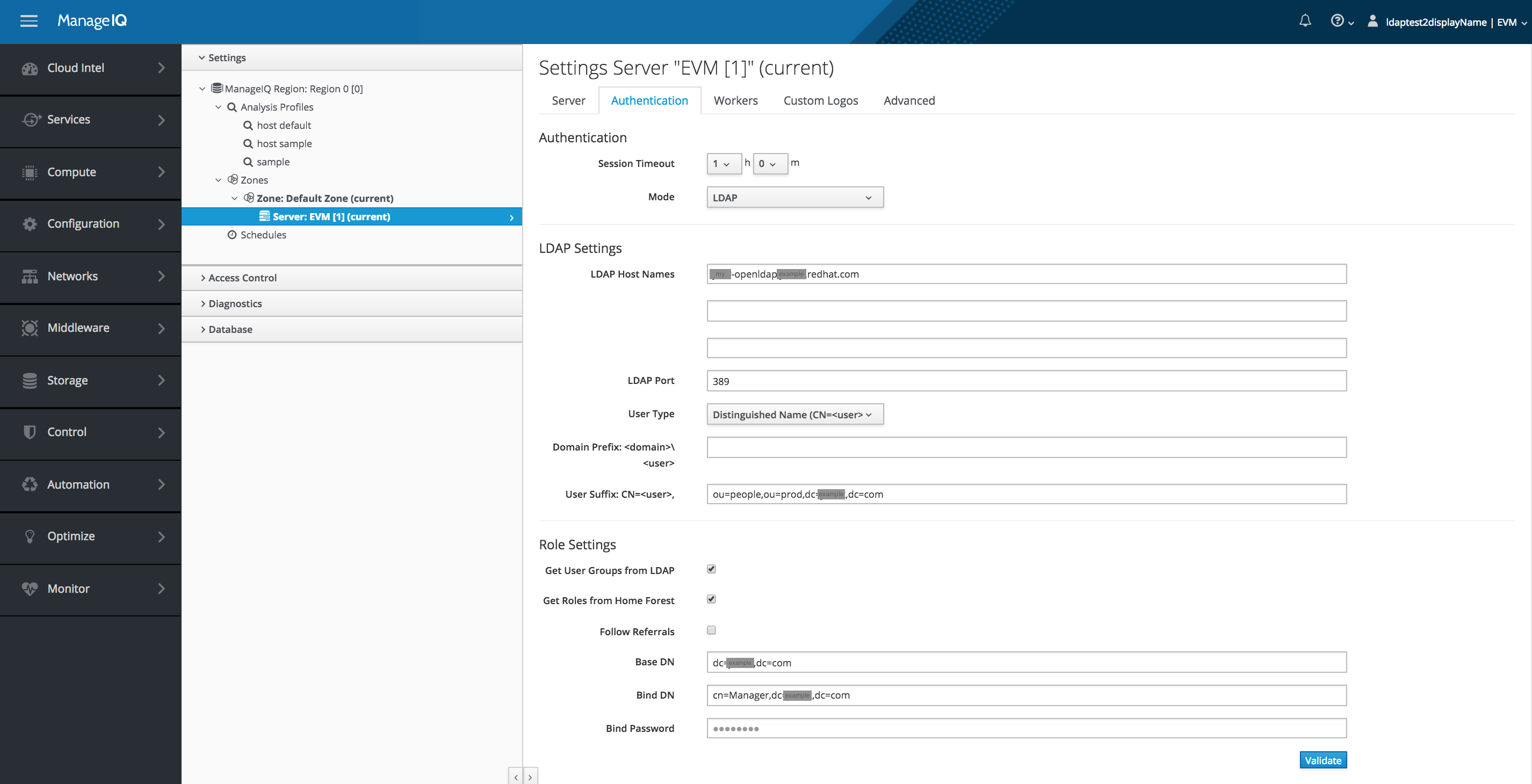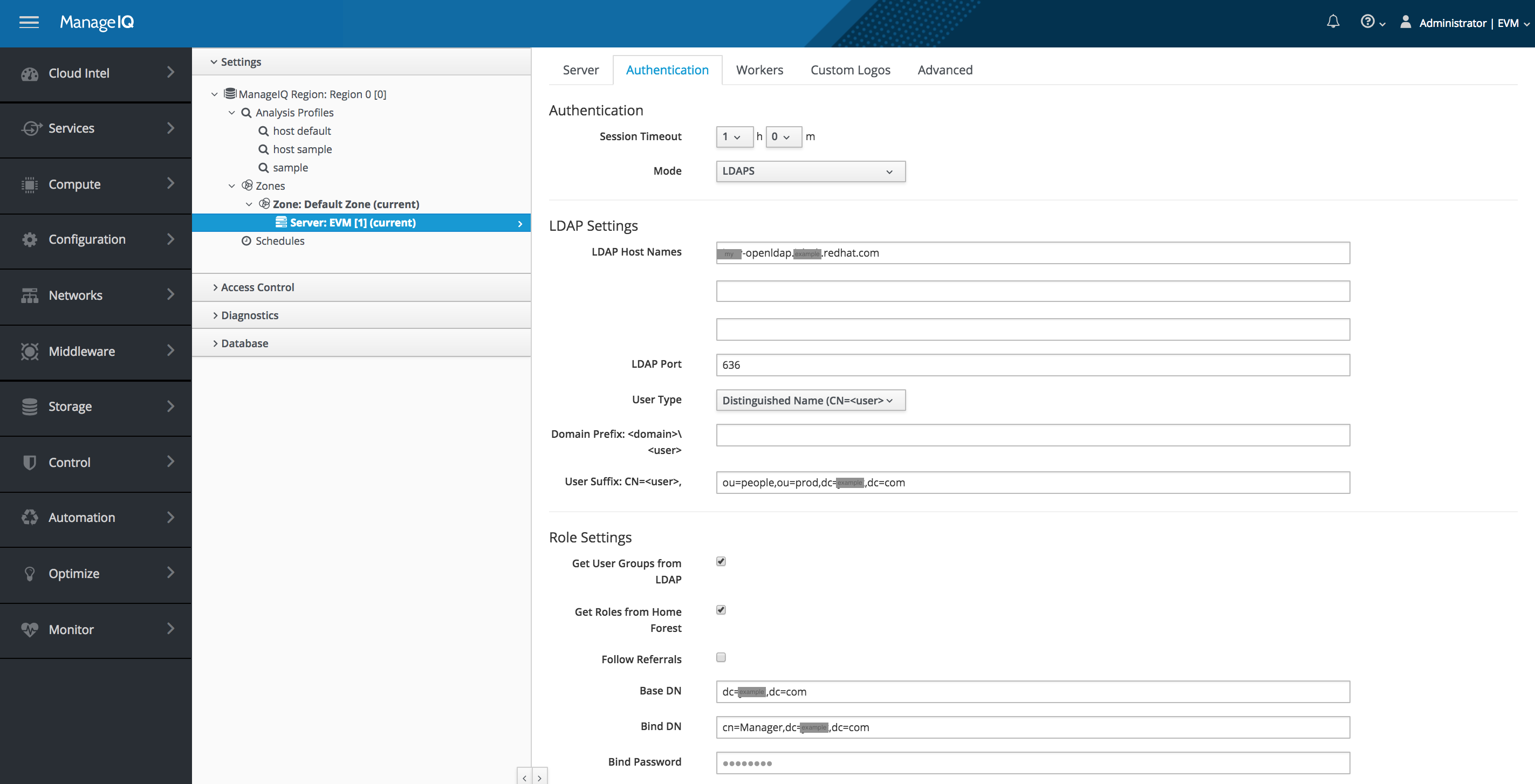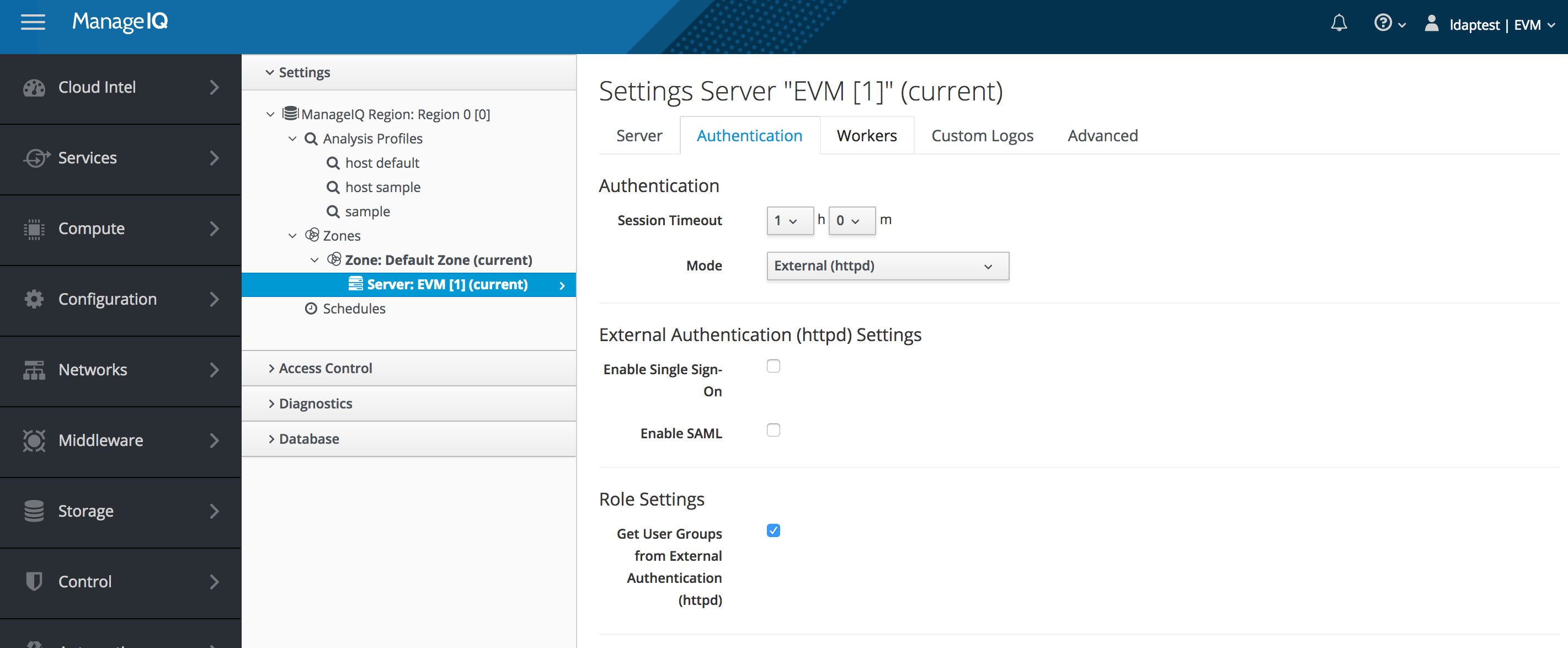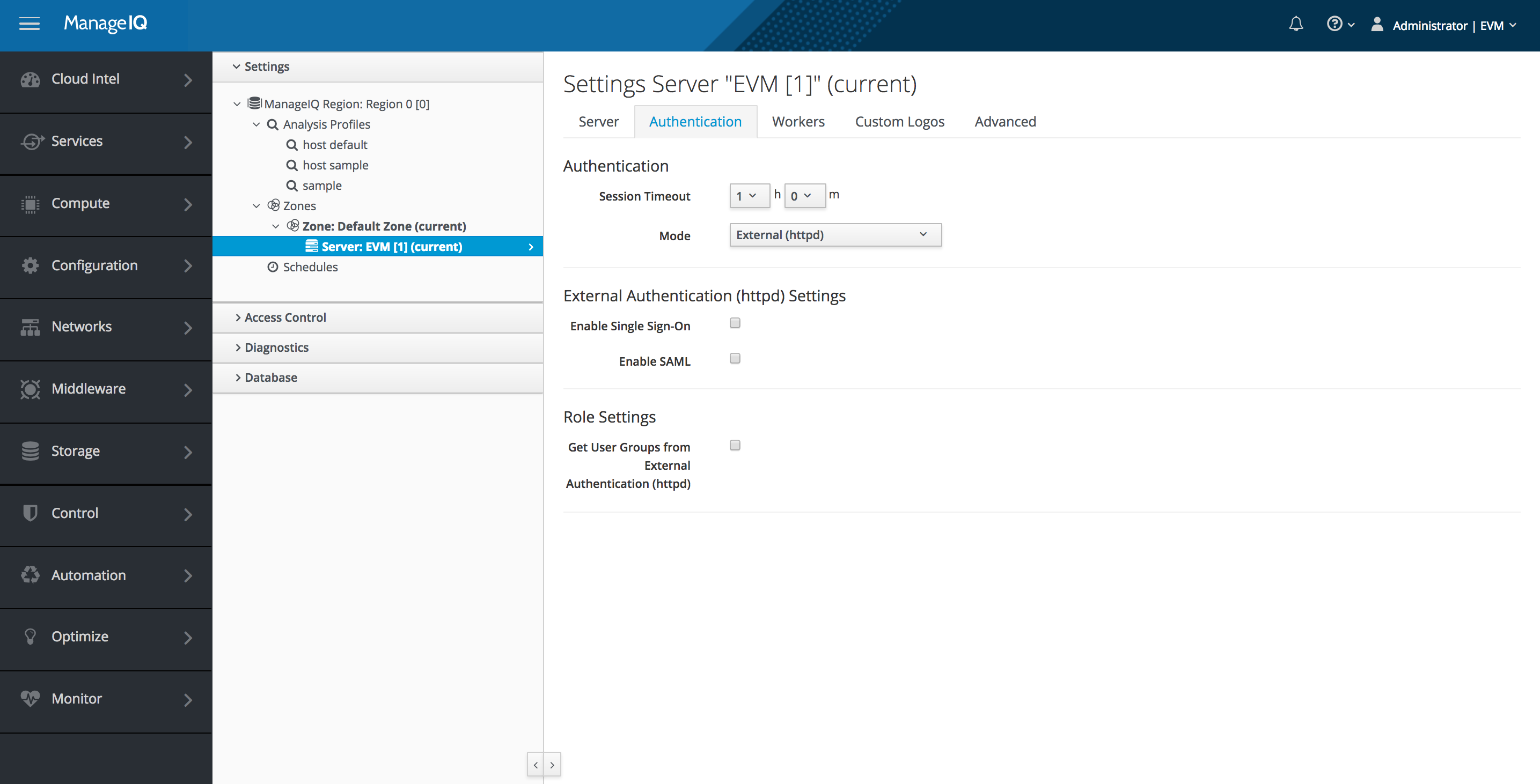MiqLdap To SSSD conversion tool
How does one use the miqldap_to_sssd conversion tool?
MiqLdap To SSSD Conversion Tool
Contents:
- A brief Why before The How
- The How
- Kicking the tires
- The other miqldap_to_sssd arguments
- Customizing The Generated Configuration
- Debugging Failed Conversions
- Edge Cases
A brief Why before The How
Why did the miqldap_to_sssd conversion tool come to be?
ManageIQ (MiQ) is delivered with the built in LDAP client, MiqLdap. There are multiple, more robust and customizable, mechanisms built into the operating system that provide an interface to an LDAP directory. The miqldap_to_sssd conversion tool is intended to automate and simplify moving to the SSSD authentication mechanism.
The How
The miqldap_to_sssd conversion tool will convert an MiQ appliance configured to use the MiqLdap client to using external authentication.
To perform this re-configuration miqldap_to_sssd simply automates the instructions for manually configuring an MiQ Appliance’s external authentication to work against LDAP (as documented here). It then customizes the configuration to emulate the MiqLdap configuration settings.
The MiqLdap client is enabled when the appliance authentication mode is set to LDAP(S) The external authentication mechanism is enabled when the appliance authentication mode is set to External (httpd)
Kicking the tires
I’ll present 3 examples:
- Example 1 The simple Case
- Authentication Mode LDAP and with Get User Groups from LDAP checked
- Example 2 A case with a small complication
- Authentication Mode LDAP but with Get User Groups from LDAP un-checked
- Example 3 A case with a different small complication
- Authentication Mode LDAPS using certificate files
Example 1 The simple Case
Prior to running the miqldap_to_sssd conversion the appliance is configured with:
Authentication Mode LDAP and with Get User Groups from LDAP checked
Authentication Configuration Settings:
| Mode: | LDAP |
| Get User Groups from LDAP: | checked |
| Get Roles from Home Forest: | checked |
| Base DN: | filled in |
| Bind DN: | filled in |
| Bind Password: | filled in |
Screenshot showing the appliance configuration for Mode: LDAP:

Note the username (userid)
- When the LDAP Host is an LDAP directory the username field stored in the MiQ database is a Distinguished Name
- e.g.: cn=user,ou=people,ou=proc,dc=example,dc=com
- When the LDAP Host is an AD directory the username field stored in the MiQ database is a User Principal Name.
- e.g.: example.com
- After the conversion to external authentication the username field stored in the MiQ database will always be User Principal Name.
Screenshot showing usernames in Distinguished Name form

Snapshot your ManageIQ Virtual machine.
The miqldap_to_sssd conversion is not reversible.
It is recommended that your ManageIQ appliance be backed up and/or a snapshot be made of the virtual machine prior to running the miqldap_to_sssd conversion tool.
Run the conversion
To run the conversion from this simple MiqLdap configuration simply execute the command miqldap_to_sssd with no arguments
Note the warning regarding the unsecured LDAP and not encrypted passwords. To avoid this start by using LDAPS with certificates or, after running miqldap_to_sssd, update the /etc/sssd/sssd.conf file to include certificates. See the LDAPS example below and the SSSD(8) man page for more information about certificates.
$ miqldap_to_sssd
Converting from unsecured LDAP authentication to SSSD. This is dangerous. Passwords are not encrypted
tools/miqldap_to_sssd.rb Conversion Completed
$
miqldap_to_sssd log
miqldap_to_sssd logs progress in file /var/www/miq/vmdb/log/miqldap_to_sssd.log
Authentication Mode External(httpd)
The miqldap_to_sssd will reconfigure the appliance for authentication Mode: External (httpd)
Note the username are User Principal Name
Now that conversion to external authentication has completed the username field will always be User Principal Name.
Example 2 A case with a small complication
Prior to running the miqldap_to_sssd conversion the appliance is configured with Authentication Mode LDAP but, and this creates the small complication, with Get User Groups from LDAP un-checked. The reason this creates the small complication is because without Get User Groups from LDAP checked the Base DN, Bind DN and Bind PWD are not prompted for and the miqldap_to_sssd conversion tool requires values for these.
Authentication Configuration Settings:
| Mode: | LDAP |
| Get User Groups from LDAP: | un-checked |
| Get Roles from Home Forest: | un-checked |
| Base DN: | empty |
| Bind DN: | empty |
| Bind Password: | empty |
Screenshot showing the appliance configuration for Mode: LDAP:

Snapshot your ManageIQ Virtual machine.
I feel compelled to repeat this.
The miqldap_to_sssd conversion is not reversible.
It is recommended that your ManageIQ appliance be backed up and/or a snapshot be made of the virtual machine prior to running the miqldap_to_sssd conversion tool.
Run the conversion
To run the conversion from this MiqLdap configuration the miqldap_to_sssd command needs to be passed the domain, bind-dn and bind-pwd arguments. This is because, with this configuration, values for these items are not available in the appliance database.
miqldap_to_sssd supports 7 arguments. This example uses the domain, bind-dn and bind-pwd arguments.
$ miqldap_to_sssd --help
Usage: ruby tools/miqldap_to_sssd.rb [options]
-d, --domain The domain name for the Base DN, e.g. example.com
-b, --bind-dn The Bind DN, credential to use to authenticate against LDAP e.g.
cn=Manager,dc=example,dc=com
-p, --bind-pwd The password for the Bind DN.
-c, --tls-cacert Path to certificate file
-n, --only-change-userids normalize the userids then exit
-s, --skip-post-conversion-userid-change Do the MiqLdap to SSSD conversion but skip the normalizing of the userids
-h, --help Show this message
Note: The Base DN must be in “dot” form e.g.: example.com
$ miqldap_to_sssd --domain example.com --bind-dn cn=Manager,dc=example,dc=com --bind-pwd password
Converting from unsecured LDAP authentication to SSSD. This is dangerous. Passwords are not encrypted
tools/miqldap_to_sssd.rb Conversion Completed
$
Authentication Mode External(httpd)
The miqldap_to_sssd will reconfigure the appliance for authentication Mode: External (httpd) and Get User Groups from External Authentication un-checked
Example 3 A case with a different small complication
Prior to running the miqldap_to_sssd conversion the appliance is configured with Authentication Mode LDAPS for secure LDAP. The source of the certificates must be passed to the miqldap_to_sssd conversion tool.
Authentication Configuration Settings:
| Mode: | LDAPS |
| Get User Groups from LDAP: | checked |
| Get Roles from Home Forest: | checked |
| Base DN: | filled in |
| Bind DN: | filled in |
| Bind Password: | filled in |
Screenshot showing the appliance configuration for Mode: LDAP:

Snapshot your ManageIQ Virtual machine.
I feel compelled to repeat this.
The miqldap_to_sssd conversion is not reversible.
It is recommended that your ManageIQ appliance be backed up and/or a snapshot be made of the virtual machine prior to running the miqldap_to_sssd conversion tool.
Run the conversion
To run the conversion from this MiqLdap configuration the miqldap_to_sssd command needs to be passed the –tls-cacert argument with the path to the certificate file.
miqldap_to_sssd supports 7 arguments. This example uses the –tls-cacert argument.
Note the warning regarding the unsecured LDAP and not encrypted passwords, is not displayed because the conversion from LDAPS preserves the certificate security.
$ miqldap_to_sssd --help
Usage: ruby tools/miqldap_to_sssd.rb [options]
-d, --domain The domain name for the Base DN, e.g. example.com
-b, --bind-dn The Bind DN, credential to use to authenticate against LDAP e.g.
cn=Manager,dc=example,dc=com
-p, --bind-pwd The password for the Bind DN.
-c, --tls-cacert Path to certificate file
-n, --only-change-userids normalize the userids then exit
-s, --skip-post-conversion-userid-change Do the MiqLdap to SSSD conversion but skip the normalizing of the userids
-h, --help Show this message
$ miqldap_to_sssd --tls-cacert /etc/openldap/certs/cacert.pem
tools/miqldap_to_sssd.rb Conversion Completed
$
Authentication Mode External(httpd)
The miqldap_to_sssd will reconfigure the appliance for authentication Mode: External (httpd)
The other miqldap_to_sssd arguments
So far only 5 of the 7 arguments supported by miqldap_to_sssd have been used. The other 2 will be explained here.
Again the 7 supported argument are:
$ miqldap_to_sssd --help
Usage: ruby tools/miqldap_to_sssd.rb [options]
-d, --domain The domain name for the Base DN, e.g. example.com
-b, --bind-dn The Bind DN, credential to use to authenticate against LDAP e.g.
cn=Manager,dc=example,dc=com
-p, --bind-pwd The password for the Bind DN.
-c, --tls-cacert Path to certificate file
-n, --only-change-userids normalize the userids then exit
-s, --skip-post-conversion-userid-change Do the MiqLdap to SSSD conversion but skip the normalizing of the userids
-h, --help Show this message
As mentioned earlier :
When the LDAP Host is an LDAP directory the username field stored in the MiQ database is a Distinguished Name
When the LDAP Host is an AD directory the username field stored in the MiQ database is a User Principal Name.
After the conversion to external authentication the username field stored in the MiQ database will always be User Principal Name.
To ensure that the username field stored in the MiQ database will always be User Principal Name the miqldap_to_sssd conversion tool will convert the username fields to User Principal Name if they are not.
If for any reason this conversion of the username field to User Principal Name is not desired the –skip-post-conversion-userid-change argument can be used.
If, on the other hand, the conversion from authentication Mode: LDAP(s): to Mode: External (httpd) is not desired the username userids can still be normalized to User Principal Name format by using the –only-change-userids argument.
Customizing The Generated Configuration
The configuration generated by the miqldap_to_sssd conversion tool will leverage the highly configurable System Security Service Daemon (SSSD).
It is beyond the scope of this document to describe the extensive configuration options. It will be left to the user to research (SSSD).
One noteworthy configuration parameter is ldap_default_authtok The miqldap_to_sssd conversion tool populates this parameter in the SSSD configuration file /etc/sssd/sssd.conf
ldap_default_authtok is a string that represents the authentication token of the default bind DN. Currently only clear text passwords are supported. Although the SSSD configuration file /etc/sssd/sssd.conf has limited ownership flags, some may want to obfuscate this. To accomplish this one could leverage the tool sss_obfuscate(8)
Debugging Failed Conversions
There are many different possible authentication configurations. Some may be encountered that result in the miqldap_to_sssd conversion tool not fully completing. If things go wrong, to diagnose why, start by examining the log file /var/www/miq/vmdb/log/miqldap_to_sssd.log
For more help diagnosing failures see the instructions for manually configuring an MiQ Appliance for external authentication. (as documented here)
This document has diagnostics tips, including:
- How to use ldapsearch, with usage examples.
- How to use dbus-send, with usage examples
- Adding debug_level=9 to the sssd.conf to produce more sssd logging information
Edge Cases
The miqldap_to_sssd conversion tool attempts to make assumptions about the initial configuration in order to produce a working SSSD configuration. Because there are so many different possibilities, these authentication configuration assumptions may not be completely accurate, resulting in an SSSD configuration that may not work correctly.
Updating the miqldap_to_sssd conversion tool to handle each edge case, as they are identified, could result in the miqldap_to_sssd conversion tool becoming bloated and unwieldy. For this reason it was decided to document edge cases, especially those not likely to be encountered by many users, here.
Edge Case 1: Active Directory configured with an atypical User Type
Cause:
- MiqLdap was configured with an Active Directory host.
- An atypical Active Directory User Type, of *Distinguished Name (CN=
* was specifed. - When miqldap_to_sssd is run it makes the incorrect assumption the that backing directory is LDAP because the specified User Type is typical for LDAP.
- miqldap_to_sssd generates an SSSD configuration with a typical LDAP group object class of groupOfNames
Fix:
- The fix is to simply update the one line in the SSSD configuration file, /etc/sssd/sssd.conf.
From: ldap_group_object_class = groupOfNames
To: ldap_group_object_class = group
- Restart
$ systemctl stop sssd.service
$ sss_cache -E
$ systemctl start sssd.service
$ systemctl status sssd.service



